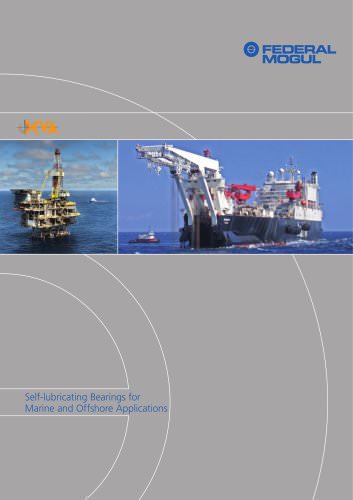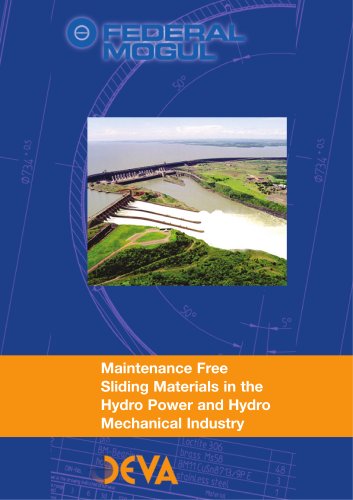 Website:
Federal-Mogul Deva GmbH
Website:
Federal-Mogul Deva GmbH
Group: Tenneco Group
Catalog excerpts

World Class Bearing Technology deva.tex® sliding bearings Maintenance-free, self-lubricating
Open the catalog to page 1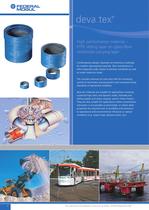
deva.tex ® High performance material – PTFE sliding layer on glass-fibre reinforced carrying layer Contemporary designs represent an enormous challenge for modern-day bearing materials. Zero maintenance is often expected under severe to extreme conditions as well as under maximum loads. The constant pressure on costs also calls for increasing uptime of machinery and equipment and uncompromising standards of operational reliability. deva.tex materials are suitable for applications involving sustained high static and dynamic loads, relatively low sliding speeds and rotary, angular, axial or...
Open the catalog to page 2
■ Profit from more than 60 years of experience in self- lubricating sliding bearings. ■ Make use of our extensive material and application expertise spanning a very wide range of industries. ■ Let our application engineering team assist you in ■ selection of the bearing materials, ■ design, purpose-built to your requirements, ■ calculation of estimated life time. ■ Benefit from the latest material developments, tested using state of the art facilities. Data relevant to the design of DEVA® bearings 17 Ask for a simulation of your bearing application on Let us analyse your bearing problem by...
Open the catalog to page 3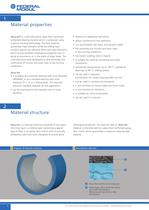
1 Material properties deva.tex® is a self-lubricating, glass-fibre reinforced composite bearing material which is produced using a special winding technology. The base material guarantees high strength, while the sliding layer contains special non-abrasive fibres and solid lubricants which ensure excellent tribological properties even in damp environments or in the event of edge loads. The solid lubricants were developed to give extremely low coefficients of friction and wear rates in dry-running conditions. deva.tex is available as a precision bearing with inner diameter H8/D8/E8, or as a...
Open the catalog to page 4
deva.tex ® maintenance-free 3 Materials Physical and mechanical properties 1) Density Table 3.1. A Linear coefficient of thermal expansion Thermal conductivity factor Radial rupture strength2) ρ g/cm³ Unit α1 10 -6/K λ W/mK σmax MPa 2.0 Symbol 13 0.3 415 deva.tex ® 552 Cyl. bearings 1) Current properties and values can be found in the DEVA® material data sheets, which are available on request. 2) Backing layer Bearing properties Table 3.1.B Permissible load static dynamic _ pstat/max Symbol Sliding speed dry _ pdyn/max dry Umax m/s MPa Unit _ pU value Temperature range 1) in water _ pU max...
Open the catalog to page 5
Chemical resistance deva.tex® sliding bearings are highly resistant to corrosive environments. Table 3.2 provides an overview of their possible applications in various media at room temperature. Their suitability for use with other media and chemicals should be checked in a resistance test according to DIN 50905 or ASTM D543. Chemical resistance of deva.tex Medium Table 3.2 resistant not resistant Alcohols Amyl alcohol Ethyl alcohol Ethylene glycol Hydroxy acetone Isobutyl alcohol Isopropyl alcohol Methyl alcohol Propyl alcohol Ammonium chloride Ammonuim nitrate Ammonium sulphate Iron...
Open the catalog to page 6
deva.tex ® maintenance-free 4 Mating material deva.tex sliding materials require the use of a mating material with a hardness of at least 180 HB. In the case of abrasive environments, a hardened mating surface should be used. The surface roughness when using deva.tex should ideally have a Ra value = 0.4 to 1.0 µm. Increased surface roughness leads only to a slightly higher wear rate. However, a decreased deviation, for example 0.4 Ra could lead to significant failure. The roughness can for example be generated by grinding or abrasive blasting. The grinding ridges should preferably run...
Open the catalog to page 7
5 Fits Recommended fitting and tolerance ranges Table 5.1 Fits Standard Precision Housing bore H7 Bearing bore (after installation) D11 Shaft h8 1) H7 D8 E8 h7 1) H8 1) d7 e7 E xception for diameter ≤ 40 mm: Quality IT9 deva.tex® is pressed into the housing with an interference fit by means of screw press, hydraulic press or press mandrel. Tapping or driving into place is not permissible. Standard housing bore is H7 Average roughness of housing: Ra = 3.2 µm The housing should be provided with a 20° - 40° chamfer for an easier installation. Higher precision standards (IT7 or better) can be...
Open the catalog to page 8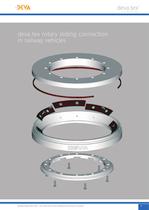
deva.tex ® maintenance-free deva.tex rotary sliding connection in railway vehicles © Federal-Mogul DEVA GmbH – The current version of this handbook can be found on our website. 9
Open the catalog to page 9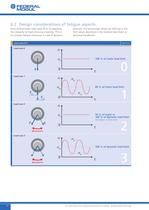
6.2 Design considerations of fatigue aspects Deva differentiates load cases (0 to 3) regarding the character of load stressing a bearing. This is to consider fatigue influences in case of dynamic pressure. The percentage values are refering to the limit values described in the material data sheet or technical handbooks. Load cases 0-3 Figure 6.2.1 Load case 0 σ σS 100 % of static load limit 0 F Load case 1 σ t σo σm F0 80 % of static load limit σu 0 FU Load case 2 t 1 σ σS 50 % of static or 100 % of dynamic load limit (the higher is value valid) F F 0 t Movement Load case 3 σ 0 Movement 2...
Open the catalog to page 10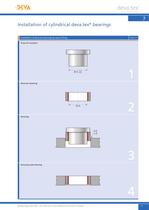
deva.tex ® maintenance-free 7 Installation of cylindrical deva.tex® bearings Installation of deva.tex bearings by press-fitting Figure 7.1 Press-fit mandrel 1 deva.tex bearing 2 Housing 3 Housing with bearing 4 © Federal-Mogul DEVA GmbH – The current version of this handbook can be found on our website. 11
Open the catalog to page 11
Installation of deva.tex sliding plates Installation of deva.tex sliding plates with countersunk screws and fixing devices As-delivered dimensions of deva.tex sliding plate Figure 7.2 Countersunk screw M8 (according to EN ISO 10642) 1 Drill tap hole 5 Fixing clamp (can be provided by DEVA) 2 Apply with cylindrical counter bore 6 3 deva.tex sliding plate after installation Machining of metric thread 4 12 7 The current version of this handbook can be found on our website. – © Federal-Mogul DEVA GmbH
Open the catalog to page 12All Federal-Mogul Deva GmbH catalogs and technical brochures
-
deva_metal_EN
21 Pages
-
deva_glide_EN
17 Pages
-
deva_tex_EN
32 Pages
-
deva_bm_EN
32 Pages
Archived catalogs
-
DEVA Spherical Bearings
32 Pages
-
deva.metal technical handbook
24 Pages
-
deva.bm technical handbook
24 Pages
-
deva.glide technical handbook
20 Pages
-
Product Range
12 Pages










